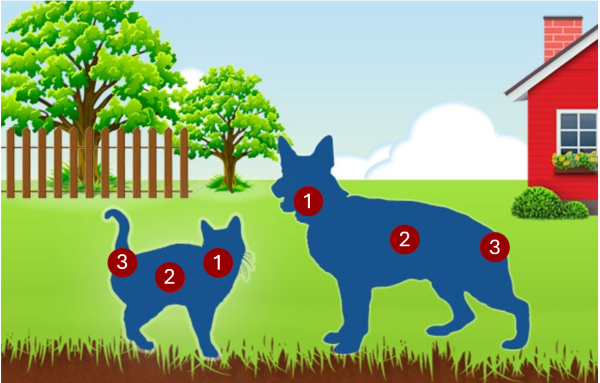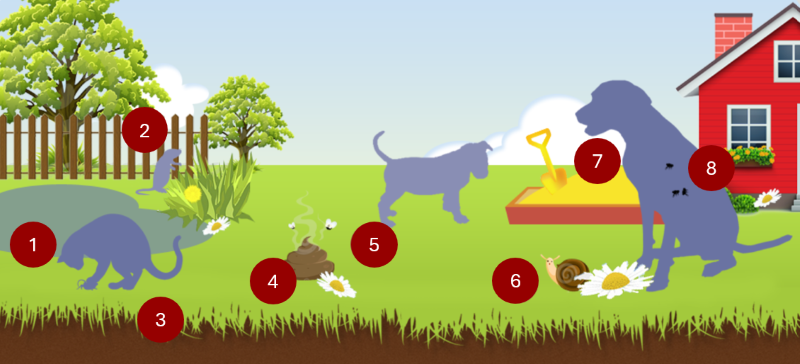What are worms in cats?
Worms are among the most common parasites that can infect cats - but what are the different types of worm, how do cats get worms in the first place, and what harm do they really do to your cat's health - or even your family's? While this may not make for particularly pleasant reading, it is a subject worth understanding...
What are the different types of worms in cats?
Roundworms and tapeworms are by far the most common worms found in cats in the UK, but there are many types of worms found in the UK, each causing similar but distinct symptoms:
 Roundworms
RoundwormsRoundworms are the most common intestinal worm in cats, and the eggs are found in the faeces of infected dogs and cats.
 Tapeworms
TapewormsTapeworms are one of the most common parasites affecting cats and one type can be spread by fleas.
 Lungworm
LungwormLungworm affects cats but they are infected by a different type of lungworm to dogs.
 Whipworms
WhipwormsWhipworms in cats aren't a problem in the UK, but cats can be affected in other parts of the world, and UK dogs are at risk from this parasite.
 Hookworms
HookwormsHookworms are rarely a problem for cats in the UK, but the parasite is more common in other parts of the world, where kittens in particular are most at risk.
 Heartworms
HeartwormsHeartworms are transmitted by mosquitoes, and have only been found in cats that have travelled from other countries. If you are taking your cat abroad, speak to your vet about preventative products.
 Eyeworms
EyewormsEyeworms occur in dogs, cats and humans in southern Europe and are transmitted by flies picking up the infection from the tears of animals and humans.
Signs of worms in cats
If your cat has worms, they might seem perfectly happy and healthy. However the worms will be multiplying inside their gut, stealing their precious nutrients and even their blood in some cases. The symptoms of worms in cats and kittens differ depending on the type of worm infection they have and can include:

- loss of appetite; vomiting*; any general changes in behaviour
- lack of energy; a dull, lifeless coat; a pot bellied appearance – particularly in puppies and kittens; breathing difficulties/heaving; coughing, laboured breathing
- 'scooting' - whereby the animal drags its bottom along the carpet; diarrhoea*; smelly stools*; blood in urine or faeces
*if you look closely you can sometimes see worms in faeces or vomit - but if you can't see anything, this doesn't mean your pet may not be infected. However, you may see a tapeworm segment stuck to the fur around their bottom or under the tail, or maybe seen in their poo. These look like a squashed grain of rice and may still be wriggling….
How do cats get worms?
It is very easy for cats to pick up worms, and given the rate at which some of the parasites multiply, they can be really difficult to avoid. See what could be lurking beneath a garden or park ...

- Scavenging: cats could become infected by eating dead animals - maybe a bird or rabbit killed on the road - or undercooked or raw meat that they might find in a bin.
- Diet: feeding raw meat or certain types of raw diet can also transmit both round or tapeworms.
- Hunting: rodents and rabbits carry worms and are a risk to hunting cats.
- Soil and sand: is often contaminated with parasitic eggs which can be easily swallowed by cats. Sandpits in particular, either at home in the garden or in parks and playgrounds, have been shown to have high levels of worm egg contamination.
- Dog or cat faeces: some worms and eggs are transmitted in the faeces of infected animals.
- Other cats: can be infected and pose a risk to your cats.
- Slugs/snails: can carry a parasite called lungworm which can be passed to your cat if they eat it.
- Sandpits: parks and playgrounds have been shown to have high levels of worm egg contamination.
- Fleas: can be infected with tapeworm which can pass to your cat if they are swallowed.
Frequently Asked Questions
Want to find out more about worms? Check out our frequently asked questions below.
